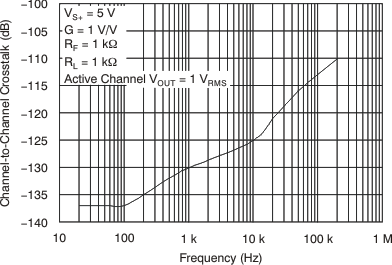SBOS458H December 2008 – June 2015 THS4521 , THS4522 , THS4524
PRODUCTION DATA.
- 1 Features
- 2 Applications
- 3 Description
- 4 Revision History
- 5 Device Comparison Table
- 6 Pin Configuration and Functions
-
7 Specifications
- 7.1 Absolute Maximum Ratings
- 7.2 ESD Ratings
- 7.3 Recommended Operating Conditions
- 7.4 Thermal Information
- 7.5 Electrical Characteristics: VS+ - VS- = 3.3 V
- 7.6 Electrical Characteristics: VS+ - VS- = 5 V
- 7.7 Typical Characteristics
- 7.8 Typical Characteristics: VS+ - VS- = 3.3 V
- 7.9 Typical Characteristics: 5 V
-
8 Detailed Description
- 8.1 Overview
- 8.2 Functional Block Diagram
- 8.3
Feature Description
- 8.3.1 Frequency Response
- 8.3.2 Distortion
- 8.3.3 Slew Rate, Transient Response, Settling Time, Output Impedance, Overdrive, Output Voltage, and Turn-On/Turn-Off Time
- 8.3.4 Common-Mode and Power-Supply Rejection
- 8.3.5 VOCM Input
- 8.3.6 Typical Performance Variation With Supply VoltageTypical Performance Variation with Supply Voltage section
- 8.3.7 title of Single-Supply Operation sectionSingle-Supply Operation
- 8.3.8 Low-Power Applications and the Effects of Resistor Values on Bandwidth
- 8.3.9 Frequency Response Variation due to Package Options
- 8.3.10 Driving Capacitive Loads
- 8.3.11 Audio Performance
- 8.3.12 Audio On/Off Pop Performance
- 8.4
Device Functional Modes
- 8.4.1
Operation from Single-Ended Sources to Differential Outputs
- 8.4.1.1 AC-Coupled Signal Path Considerations for Single-Ended Input to Differential Output Conversion
- 8.4.1.2 DC-Coupled Input Signal Path Considerations for Single-Ended to Differential Conversion
- 8.4.1.3 Resistor Design Equations for the Single-Ended to Differential Configuration of the FDA
- 8.4.1.4 Input Impedance for the Single-Ended to Differential FDA Configuration
- 8.4.2 Differential-Input to Differential-Output Operation
- 8.4.1
Operation from Single-Ended Sources to Differential Outputs
- 8.5 Programming
-
9 Application and Implementation
- 9.1 Application Information
- 9.2 Typical Applications
- 10Power Supply Recommendations
- 11Layout
- 12Device and Documentation Support
- 13Mechanical, Packaging, and Orderable Information
7 Specifications
7.1 Absolute Maximum Ratings
Over operating free-air temperature range (unless otherwise noted).(1)| MIN | MAX | UNIT | ||
|---|---|---|---|---|
| Supply voltage, VS– to VS+ | 5.5 | V | ||
| Input/output voltage, VI (VIN±, VOUT±, VOCM pins) | (VS–) – 0.7 | (VS+) + 0.7 | V | |
| Differential input voltage, VID | 1 | V | ||
| Output current, IO | 100 | mA | ||
| Input current, II (VIN±, VOCM pins) | 10 | mA | ||
| Continuous power dissipation | See Thermal Information table | |||
| Maximum junction temperature, TJ | 150 | °C | ||
| Maximum junction temperature, TJ (continuous operation, long-term reliability) | 125 | °C | ||
| Operating free-air temperature, TA | –40 | 85 | °C | |
| Storage temperature, Tstg | –65 | 150 | °C | |
(1) Stresses beyond those listed under Absolute Maximum Ratings may cause permanent damage to the device. These are stress ratings only, which do not imply functional operation of the device at these or any other conditions beyond those indicated under Recommended Operating Conditions. Exposure to absolute-maximum-rated conditions for extended periods may affect device reliability.
7.2 ESD Ratings
| VALUE | UNIT | |||
|---|---|---|---|---|
| V(ESD) | Electrostatic discharge | Human body model (HBM), per ANSI/ESDA/JEDEC JS-001, all pins(1) | ±1300 | V |
| Charged device model (CDM), per JEDEC specification JESD22-C101, all pins(2) | ±1000 | |||
| Machine model (MM) | ±50 | |||
(1) JEDEC document JEP155 states that 500-V HBM allows safe manufacturing with a standard ESD control process.
(2) JEDEC document JEP157 states that 250-V CDM allows safe manufacturing with a standard ESD control process.
7.3 Recommended Operating Conditions
over operating free-air temperature range (unless otherwise noted)| MIN | NOM | MAX | UNIT | ||
|---|---|---|---|---|---|
| VS+ single-supply voltage | 2.7 | 5.0 | 5.4 | V | |
| TA Ambient temperature | –40 | 25 | 85 | °C | |
7.4 Thermal Information
| THERMAL METRIC(1) | THS4521 | THS4522 | THS4524 | UNIT | ||
|---|---|---|---|---|---|---|
| D | DGK | PW | DBT | |||
| 8 PINS | 8 PINS | 16 PINS | 38 PINS | |||
| RθJA | Junction-to-ambient thermal resistance | 127.8 | 193.8 | 124.2 | 106.2 | °C/W |
| RθJC(top) | Junction-to-case (top) thermal resistance | 81.8 | 84.1 | 62.8 | 60.9 | |
| RθJB | Junction-to-board thermal resistance | 68.3 | 115.3 | 68.5 | 65.5 | |
| ψJT | Junction-to-top characterization parameter | 32.2 | 17.9 | 15.8 | 18.5 | |
| ψJB | Junction-to-board characterization parameter | 67.8 | 113.6 | 68 | 65.1 | |
| RθJC(bot) | Junction-to-case (bottom) thermal resistance | N/A | N/A | N/A | N/A | |
(1) For more information about traditional and new thermal metrics, see the IC Package Thermal Metrics application report, SPRA953.
7.5 Electrical Characteristics: VS+ – VS– = 3.3 V
At VS+ = 3.3 V, VS– = 0 V, VOCM = open, VOUT = 2 VPP (differential), RL = 1 kΩ differential, G = 1 V/V, single-ended input, differential output, and input and output referenced to midsupply, unless otherwise noted.| PARAMETER | TEST CONDITIONS | TEST LEVEL(1) | MIN | TYP | MAX | UNIT | ||
|---|---|---|---|---|---|---|---|---|
| AC PERFORMANCE | ||||||||
| Small-signal bandwidth | VOUT = 100 mVPP, G = 1 | C | 135 | MHz | ||||
| VOUT = 100 mVPP, G = 2 | C | 49 | MHz | |||||
| VOUT = 100 mVPP, G = 5 | C | 18.6 | MHz | |||||
| VOUT = 100 mVPP, G = 10 | C | 9.3 | MHz | |||||
| Gain bandwidth product | VOUT = 100 mVPP, G = 10 | C | 93 | MHz | ||||
| Large-signal bandwidth | VOUT = 2 VPP, G = 1 | C | 95 | MHz | ||||
| Bandwidth for 0.1-dB flatness | VOUT = 2 VPP, G = 1 | C | 20 | MHz | ||||
| Rising slew rate (differential) | VOUT = 2-V Step, G = 1, RL = 200 Ω | C | 420 | V/μs | ||||
| Falling slew rate (differential) | VOUT = 2-V Step, G = 1, RL = 200 Ω | C | 460 | V/μs | ||||
| Overshoot | VOUT = 2-V Step, G = 1, RL = 200 Ω | C | 1.2% | |||||
| Undershoot | VOUT = 2-V Step, G = 1, RL = 200 Ω | C | 2.1% | |||||
| Rise time | VOUT = 2-V Step, G = 1, RL = 200 Ω | C | 4 | ns | ||||
| Fall time | VOUT = 2-V Step, G = 1, RL = 200 Ω | C | 3.5 | ns | ||||
| Settling time to 1% | VOUT = 2-V Step, G = 1, RL = 200 Ω | C | 13 | ns | ||||
| HARMONIC DISTORTION | ||||||||
| 2nd harmonic | f = 1 MHz, VOUT = 2 VPP, G = 1 | C | –85 | dBc | ||||
| f = 1 kHz, VOUT = 1 VRMS, G = 1(3), differential input |
C | –133 | dBc | |||||
| 3rd harmonic | f = 1 MHz, VOUT = 2 VPP, G = 1 | C | –90 | dBc | ||||
| f = 1 kHz, VOUT = 1 VRMS, G = 1(3), differential input |
C | –141 | dBc | |||||
| Second-order intermodulation distortion | Two-tone, f1 = 2 MHz, f2 = 2.2 MHz, VOUT = 2-VPP envelope |
C | –83 | dBc | ||||
| Third-order intermodulation distortion | Two-tone, f1 = 2 MHz, f2 = 2.2 MHz, VOUT = 2-VPP envelope |
C | –90 | dBc | ||||
| Input voltage noise | f > 10 kHz | C | 4.6 | nV/√Hz | ||||
| Input current noise | f > 100 kHz | C | 0.6 | pA/√Hz | ||||
| Overdrive recovery time | Overdrive = ±0.5 V | C | 80 | ns | ||||
| Output balance error | VOUT = 100 mV, f ≤ 2 MHz (differential input) | C | –57 | dB | ||||
| Closed-loop output impedance | f = 1 MHz (differential) | C | 0.3 | Ω | ||||
| Channel-to-channel crosstalk (THS4522, THS4524) | f = 10 kHz, measured differentially | C | –125 | dB | ||||
| DC PERFORMANCE | ||||||||
| Open-loop voltage gain (AOL) | A | 100 | 116 | dB | ||||
| Input-referred offset voltage | TA = +25°C | A | ±0.2 | ±2 | mV | |||
| TA = –40°C to +85°C | B | ±0.5 | ±3.5 | mV | ||||
| Input offset voltage drift(2) | TA = –40°C to +85°C | C | ±2 | μV/°C | ||||
| Input bias current(4) | TA = +25°C | B | 0.65 | 0.85 | μA | |||
| TA = –40°C to +85°C | B | 0.75 | 0.95 | μA | ||||
| Input bias current drift(2) | TA = –40°C to +85°C | B | ±1.75 | ±2 | nA/°C | |||
| Input offset current | TA = +25°C | B | ±30 | ±180 | nA | |||
| TA = –40°C to +85°C | B | ±30 | ±215 | nA | ||||
| Input offset current drift(2) | TA = –40°C to +85°C | B | ±100 | ±600 | pA/°C | |||
| INPUT | ||||||||
| Common-mode input voltage low | TA = +25°C | A | –0.2 | –0.1 | V | |||
| TA = –40°C to +85°C | B | –0.1 | 0 | V | ||||
| Common-mode input voltage high | TA = +25°C | A | 1.9 | 2 | V | |||
| TA = –40°C to +85°C | B | 1.8 | 1.9 | V | ||||
| Common-mode rejection ratio (CMRR) | A | 80 | 100 | dB | ||||
| Input impedance | C | 0.7 pF | kΩ∥pF | |||||
| OUTPUT | ||||||||
| Output voltage low | TA = +25°C | A | 0.08 | 0.15 | V | |||
| TA = –40°C to +85°C | B | 0.09 | 0.2 | V | ||||
| Output voltage high | TA = +25°C | A | 3.0 | 3.1 | V | |||
| TA = –40°C to +85°C | B | 2.95 | 3.05 | V | ||||
| Output current drive (for linear operation) | RL = 50 Ω | C | ±35 | mA | ||||
| POWER SUPPLY | ||||||||
| Specified operating voltage | B | 2.5 | 3.3 | 5.5 | V | |||
| Quiescent operating current, per channel | TA = +25°C | A | 0.9 | 1.0 | 1.2 | mA | ||
| TA = –40°C to +85°C | B | 0.85 | 1.0 | 1.25 | mA | |||
| Power-supply rejection ratio (±PSRR) | A | 80 | 100 | dB | ||||
| POWER DOWN | ||||||||
| Enable voltage threshold | Assured on above 2.1 V | A | 1.6 | 2.1 | V | |||
| Disable voltage threshold | Assured off below 0.7 V | A | 0.7 | 1.6 | V | |||
| Disable pin bias current | C | 1 | μA | |||||
| Power-down quiescent current | C | 10 | μA | |||||
| Turn-on time delay | Time to VOUT = 90% of final value, VIN= 2 V, RL = 200 Ω | B | 108 | ns | ||||
| Turn-off time delay | Time to VOUT = 10% of original value, VIN= 2 V, RL = 200 Ω | B | 88 | ns | ||||
| VOCM VOLTAGE CONTROL | ||||||||
| Small-signal bandwidth | C | 23 | MHz | |||||
| Slew rate | C | 55 | V/μs | |||||
| Gain | A | 0.98 | 0.99 | 1.02 | V/V | |||
| Common-mode offset voltage from VOCM input | Measured at VOUT with VOCM input driven, VOCM = 1.65 V ±0.5 V | B | ±2.5 | ±4 | mV | |||
| Input bias current | VOCM = 1.65 V ±0.5 V | B | ±5 | ±8 | μA | |||
| VOCM voltage range | A | 1 | 0.8 to 2.5 | 2.3 | V | |||
| Input impedance | C | 72∥1.5 | kΩ∥pF | |||||
| Default output common-mode voltage offset from (VS+– VS–) / 2 | Measured at VOUT with VOCM input open | A | ±1.5 | ±5 | mV | |||
(1) Test levels: (A) 100% tested at 25°C. Over temperature limits set by characterization and simulation. (B) Limits set by characterization and simulation. (C) Typical value only for information.
(2) Input offset voltage drift, input bias current drift, input offset current drift, and VOCM drift are average values calculated by taking data at the maximum-range ambient-temperature end points, computing the difference, and dividing by the temperature range. Maximum drift is set by the distribution of a large sampling of devices. Drift is not specified by a test or a quality assurance (QA) sample test.
(3) Not directly measurable; calculated using noise gain of 101 as described in the Applications section, Audio Performance.
(4) Input bias current is positive out of the device.
7.6 Electrical Characteristics: VS+ – VS– = 5 V
At VS+ = 5 V, VS– = 0 V, VOCM = open, VOUT = 2 VPP (differential), RF = 1 kΩ, RL = 1 kΩ differential, G = 1 V/V, single-ended input, differential output, input and output referenced to midsupply, unless otherwise noted.| PARAMETER | TEST CONDITIONS | TEST LEVEL(1) | MIN | TYP | MAX | UNIT | ||
|---|---|---|---|---|---|---|---|---|
| AC PERFORMANCE | ||||||||
| Small-signal bandwidth | VOUT = 100 mVPP, G = 1 | C | 145 | MHz | ||||
| VOUT = 100 mVPP, G = 2 | C | 50 | MHz | |||||
| VOUT = 100 mVPP, G = 5 | C | 20 | MHz | |||||
| VOUT = 100 mVPP, G = 10 | C | 9.5 | MHz | |||||
| Gain bandwidth product | VOUT = 100 mVPP, G = 10 | C | 95 | MHz | ||||
| Large-signal bandwidth | VOUT = 2 VPP, G = 1 | C | 145 | MHz | ||||
| Bandwidth for 0.1-dB flatness | VOUT = 2 VPP, G = 1 | C | 30 | MHz | ||||
| Rising slew rate (differential) | VOUT = 2-V Step, G = 1, RL = 200 Ω | C | 490 | V/μs | ||||
| Falling slew rate (differential) | VOUT = 2-V Step, G = 1, RL = 200 Ω | C | 600 | V/μs | ||||
| Overshoot | VOUT = 2-V Step, G = 1, RL = 200 Ω | C | 1% | |||||
| Undershoot | VOUT = 2-V Step, G = 1, RL = 200 Ω | C | 2.6% | |||||
| Rise time | VOUT = 2-V Step, G = 1, RL = 200 Ω | C | 3.4 | ns | ||||
| Fall time | VOUT = 2-V Step, G = 1, RL = 200 Ω | C | 3 | ns | ||||
| Settling time to 1% | VOUT = 2-V Step, G = 1, RL = 200 Ω | C | 10 | ns | ||||
| HARMONIC DISTORTION | ||||||||
| 2nd harmonic | f = 1 MHz, VOUT = 2 VPP, G = 1 | C | –85 | dBc | ||||
| f = 1 kHz, VOUT = 1 VRMS, G = 1(3), differential input |
C | –133 | dBc | |||||
| 3rd harmonic | f = 1 MHz, VOUT = 2 VPP, G = 1 | C | –91 | dBc | ||||
| f = 1 kHz, VOUT = 1 VRMS, G = 1(3), differential input |
C | –141 | dBc | |||||
| Second-order intermodulation distortion | Two-tone, f1 = 2 MHz, f2 = 2.2 MHz, VOUT = 2-VPP envelope |
C | –86 | dBc | ||||
| Third-order intermodulation distortion | Two-tone, f1 = 2 MHz, f2 = 2.2 MHz, VOUT = 2-VPP envelope |
C | –93 | dBc | ||||
| Input voltage noise | f > 10 kHz | C | 4.6 | nV/√Hz | ||||
| Input current noise | f > 100 kHz | C | 0.6 | pA/√Hz | ||||
| SNR | VOUT = 5 VPP, 20 Hz to 22 kHz BW, differential input | C | 123 | dBc | ||||
| THD+N | f = 1 kHz , VOUT = 5 VPP, 20 Hz to 22 kHz BW, differential input | C | 112 | dBc | ||||
| Overdrive recovery time | Overdrive = ±0.5 V | C | 75 | ns | ||||
| Output balance error | VOUT = 100 mV, f < 2 MHz, VIN differential | C | –57 | dB | ||||
| Closed-loop output impedance | f = 1 MHz (differential) | C | 0.3 | Ω | ||||
| Channel-to-channel crosstalk (THS4522. THS4524) | f = 10 kHz, measured differentially | C | –125 | dB | ||||
| DC PERFORMANCE | ||||||||
| Open-loop voltage gain (AOL) | A | 100 | 119 | dB | ||||
| Input-referred offset voltage | TA = +25°C | A | ±0.24 | ±2 | mV | |||
| TA = –40°C to +85°C | B | ±0.5 | ±3.5 | mV | ||||
| Input offset voltage drift(2) | TA = –40°C to +85°C | C | ±2 | μV/°C | ||||
| Input bias current(4) | TA = +25°C | B | 0.7 | 0.9 | μA | |||
| TA = –40°C to +85°C | B | 0.9 | 1.1 | μA | ||||
| Input bias current drift(2) | TA = –40°C to +85°C | B | ±1.8 | ±2.2 | nA/°C | |||
| Input offset current | TA = +25°C | B | ±30 | ±180 | nA | |||
| TA = –40°C to +85°C | B | ±30 | ±215 | nA | ||||
| Input offset current drift(2) | TA = –40°C to +85°C | B | ±100 | ±600 | pA/°C | |||
| INPUT | ||||||||
| Common-mode input voltage low | TA = +25°C | A | –0.2 | –0.1 | V | |||
| TA = –40°C to +85°C | B | –0.1 | 0 | V | ||||
| Common-mode input voltage high | TA = +25°C | A | 3.6 | 3.7 | V | |||
| TA = –40°C to +85°C | B | 3.5 | 3.6 | V | ||||
| Common-mode rejection ratio (CMRR) | A | 80 | 102 | dB | ||||
| Input impedance | C | 100∥0.7 | kΩ∥pF | |||||
| OUTPUT | ||||||||
| Output voltage low | TA = +25°C | A | 0.10 | 0.15 | V | |||
| TA = –40°C to +85°C | B | 0.115 | 0.2 | V | ||||
| Output voltage high | TA = +25°C | A | 4.7 | 4.75 | V | |||
| TA = –40°C to +85°C | B | 4.65 | 4.7 | V | ||||
| Output current drive (for linear operation) | RL = 50 Ω | C | ±55 | mA | ||||
| POWER SUPPLY | ||||||||
| Specified operating voltage | B | 2.5 | 5.0 | 5.5 | V | |||
| Quiescent operating current, per channel | TA = +25°C | A | 0.95 | 1.14 | 1.25 | mA | ||
| TA = –40°C to +85°C | B | 0.9 | 1.15 | 1.3 | mA | |||
| Power-supply rejection ratio (±PSRR) | A | 80 | 100 | dB | ||||
| POWER DOWN | ||||||||
| Enable voltage threshold | Ensured on above 2.1 V | A | 1.6 | 2.1 | V | |||
| Disable voltage threshold | Ensured off below 0.7 V | A | 0.7 | 1.6 | V | |||
| Disable pin bias current | C | 1 | μA | |||||
| Power-down quiescent current | C | 20 | μA | |||||
| Turn-on time delay | Time to VOUT = 90% of final value, VIN= 2 V, RL = 200 Ω |
B | 70 | ns | ||||
| Turn-off time delay | Time to VOUT = 10% of original value, VIN= 2 V, RL = 200 Ω |
B | 60 | ns | ||||
| VOCM VOLTAGE CONTROL | ||||||||
| Small-signal bandwidth | C | 23 | MHz | |||||
| Slew rate | C | 55 | V/μs | |||||
| Gain | A | 0.98 | 0.99 | 1.02 | V/V | |||
| Common-mode offset voltage from VOCM input | Measured at VOUT with VOCM input driven, VOCM = 2.5 V ±1 V | B | ±5 | ±9 | mV | |||
| Input bias current | VOCM = 2.5V ±1 V | B | ±20 | ±25 | μA | |||
| VOCM voltage range | A | 1 | 0.8 to 4.2 | 4 | V | |||
| Input impedance | C | 46∥1.5 | kΩ∥pF | |||||
| Default output common-mode voltage offset from (VS+– VS–) / 2 | Measured at VOUT with VOCM input open | A | ±1 | ±5 | mV | |||
(1) Test levels: (A) 100% tested at 25°C. Over temperature limits set by characterization and simulation. (B) Limits set by characterization and simulation. (C) Typical value only for information.
(2) Input offset voltage drift, input bias current drift, input offset current drift, and VOCM drift are average values calculated by taking data at the maximum-range ambient-temperature end points, computing the difference, and dividing by the temperature range. Maximum drift is set by the distribution of a large sampling of devices. Drift is not specified by a test or a quality assurance (QA) sample test.
(3) Not directly measurable; calculated using noise gain of 101 as described in the Applications section, Audio Performance.
(4) Input bias current is positive out of the device.
7.7 Typical Characteristics
Table 2. Table of Graphs: VS+ – VS– = 3.3 V
| FIGURE | |
|---|---|
| Small-Signal Frequency Response | Figure 1 |
| Large-Signal Frequency Response | Figure 2 |
| Large- and Small-Signal Pulse Response | Figure 3 |
| Slew Rate vs VOUT Step | Figure 4 |
| Overdrive Recovery | Figure 5 |
| 10-kHz Output Spectrum on AP Analyzer | Figure 6 |
| Harmonic Distortion vs Frequency | Figure 7 |
| Harmonic Distortion vs Output Voltage at 1 MHz | Figure 8 |
| Harmonic Distortion vs Gain at 1 MHz | Figure 9 |
| Harmonic Distortion vs Load at 1 MHz | Figure 10 |
| Harmonic Distortion vs VOCM at 1 MHz | Figure 11 |
| Two-Tone, Second- and Third-Order Intermodulation Distortion vs Frequency | Figure 12 |
| Single-Ended Output Voltage Swing vs Load Resistance | Figure 13 |
| Main Amplifier Differential Output Impedance vs Frequency | Figure 14 |
| Frequency Response vs CLOAD (RLOAD = 1 kΩ) | Figure 15 |
| RO vs CLOAD (RLOAD = 1 kΩ) | Figure 16 |
| Rejection Ratio vs Frequency | Figure 17 |
| THS4522, THS4524 Crosstalk (Measured Differentially) | Figure 18 |
| Turn-on Time | Figure 19 |
| Turn-off Time | Figure 20 |
| Input-Referred Voltage Noise and Current Noise Spectral Density | Figure 21 |
| Main Amplifier Differential Open-Loop Gain and Phase | Figure 22 |
| Output Balance Error vs Frequency | Figure 23 |
| VOCM Small-Signal Frequency Response | Figure 24 |
| VOCM Large-Signal Frequency Response | Figure 25 |
| VOCM Input Impedance vs Frequency | Figure 26 |
Table 3. Table of Graphs: VS+ – VS– = 5 V
| FIGURE | |
|---|---|
| Small-Signal Frequency Response | Figure 27 |
| Large-Signal Frequency Response | Figure 28 |
| Large- and Small-Signal Pulse Response | Figure 29 |
| Slew Rate vs VOUT Step | Figure 30 |
| Overdrive Recovery | Figure 31 |
| 10-kHz Output Spectrum on AP Analyzer | Figure 33 |
| Harmonic Distortion vs Frequency | Figure 34 |
| Harmonic Distortion vs Output Voltage at 1 MHz | Figure 35 |
| Harmonic Distortion vs Gain at 1 MHz | Figure 36 |
| Harmonic Distortion vs Load at 1 MHz | Figure 37 |
| Harmonic Distortion vs VOCM at 1 MHz | Figure 38 |
| Two-Tone, Second- and Third-Order Intermodulation Distortion vs Frequency | Figure 39 |
| Single-Ended Output Voltage Swing vs Load Resistance | Figure 40 |
| Main Amplifier Differential Output Impedance vs Frequency | Figure 41 |
| Frequency Response vs CLOAD (RLOAD = 1 kΩ) | Figure 42 |
| RO vs CLOAD (RLOAD = 1 kΩ) | Figure 43 |
| Rejection Ratio vs Frequency | Figure 44 |
| THS4522, THS4524 Crosstalk (Measured Differentially) | Figure 45 |
| Turn-on Time | Figure 46 |
| Turn-off Time | Figure 47 |
| Input-Referred Voltage Noise and Current Noise Spectral Density | Figure 48 |
| Main Amplifier Differential Open-Loop Gain and Phase | Figure 49 |
| Output Balance Error vs Frequency | Figure 50 |
| VOCM Small-Signal Frequency Response | Figure 51 |
| VOCM Large-Signal Frequency Response | Figure 52 |
| VOCM Input Impedance vs Frequency | Figure 53 |
7.8 Typical Characteristics: VS+ – VS– = 3.3 V
At VS+ = +3.3 V, VS– = 0 V, VOCM = open, VOUT = 2 VPP (differential), RF = 1 kΩ, RL = 1 kΩ differential, G = 1 V/V, single-ended input, differential output, and input and output referenced to midsupply, unless otherwise noted.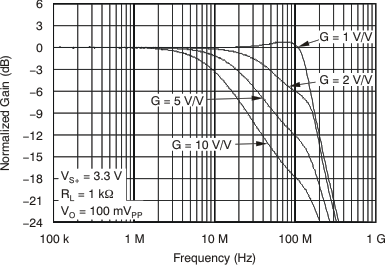 Figure 1. Small-Signal Frequency Response
Figure 1. Small-Signal Frequency Response
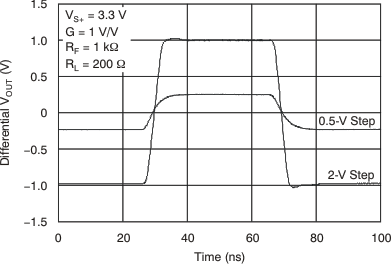 Figure 3. Large- and Small-Signal Pulse Response
Figure 3. Large- and Small-Signal Pulse Response
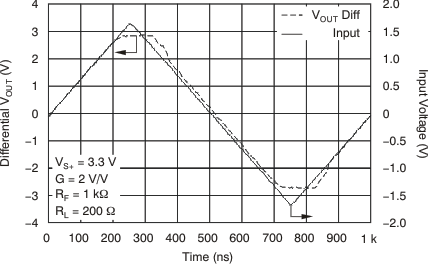 Figure 5. Overdrive Recovery
Figure 5. Overdrive Recovery
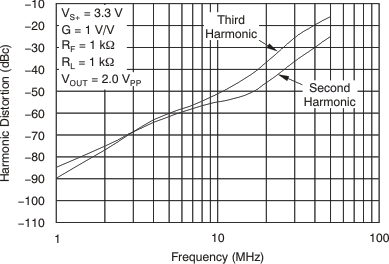 Figure 7. Harmonic Distortion vs Frequency
Figure 7. Harmonic Distortion vs Frequency
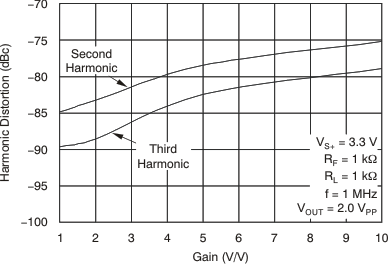 Figure 9. Harmonic Distortion vs Gain at 1 MHz
Figure 9. Harmonic Distortion vs Gain at 1 MHz
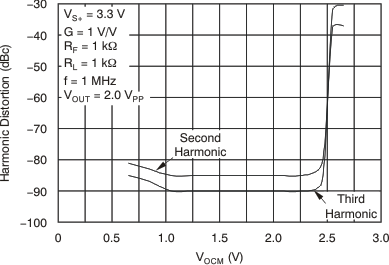 Figure 11. Harmonic Distortion vs VOCM at 1 MHz
Figure 11. Harmonic Distortion vs VOCM at 1 MHz
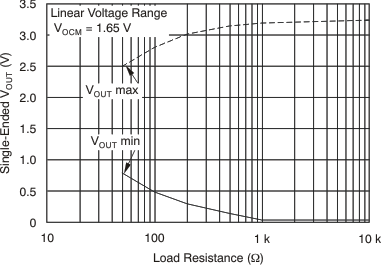 Figure 13. Single-Ended Output Voltage Swing vs Load Resistance
Figure 13. Single-Ended Output Voltage Swing vs Load Resistance
 Figure 15. Frequency Response vs CLOAD RLOAD = 1 kΩ
Figure 15. Frequency Response vs CLOAD RLOAD = 1 kΩ
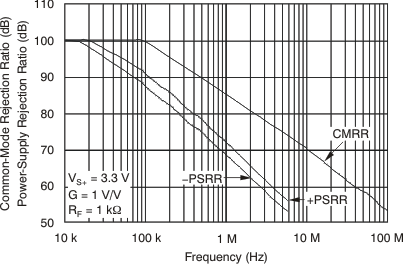 Figure 17. Rejection Ratio vs Frequency
Figure 17. Rejection Ratio vs Frequency
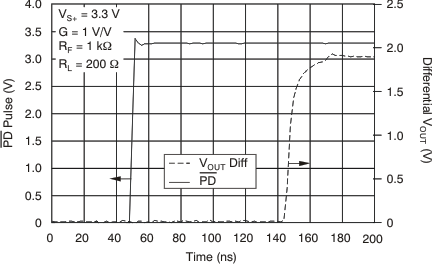 Figure 19. Turn-On Time
Figure 19. Turn-On Time
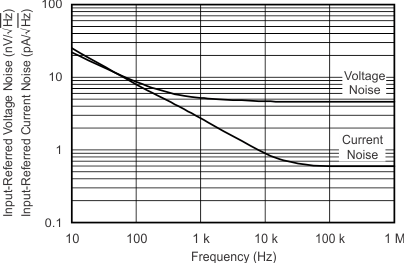 Figure 21. Input-Referred Voltage and Current Noise Spectral Density
Figure 21. Input-Referred Voltage and Current Noise Spectral Density
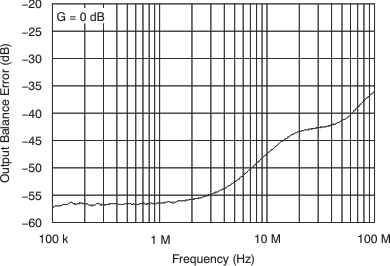 Figure 23. Output Balance Error vs Frequency
Figure 23. Output Balance Error vs Frequency
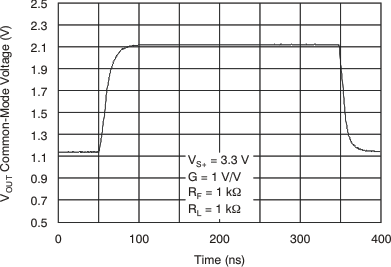 Figure 25. VOCM Large-Signal Pulse Response
Figure 25. VOCM Large-Signal Pulse Response
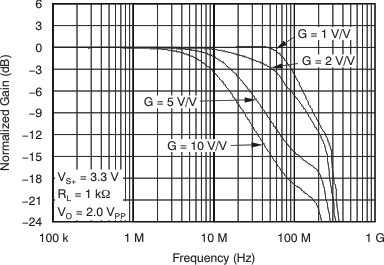 Figure 2. Large-Signal Frequency Response
Figure 2. Large-Signal Frequency Response
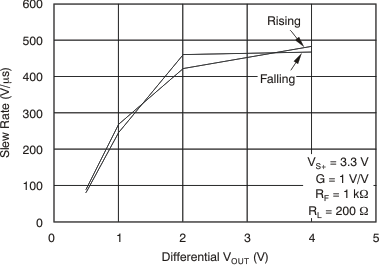 Figure 4. Slew Rate vs VOUT
Figure 4. Slew Rate vs VOUT
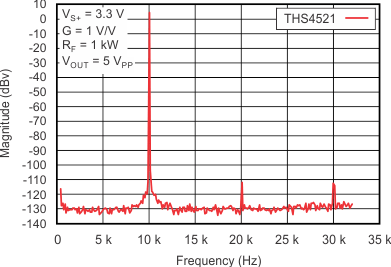 Figure 6. 10-kHz Output Spectrum On AP Analyzer
Figure 6. 10-kHz Output Spectrum On AP Analyzer
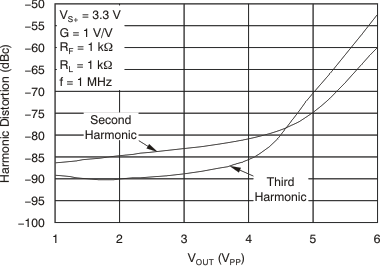 Figure 8. Harmonic Distortion vs VOUT at 1 MHz
Figure 8. Harmonic Distortion vs VOUT at 1 MHz
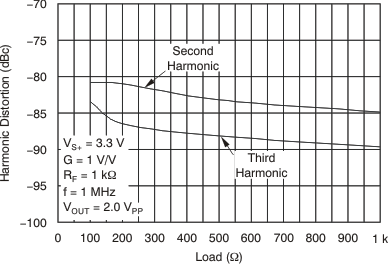 Figure 10. Harmonic Distortion vs Load at 1 MHz
Figure 10. Harmonic Distortion vs Load at 1 MHz
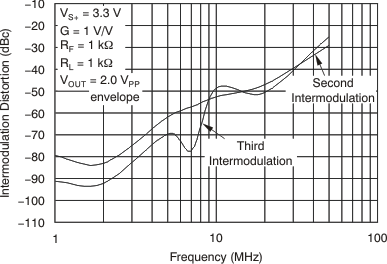 Figure 12. Two-Tone Intermodulation Distortion vs Frequency
Figure 12. Two-Tone Intermodulation Distortion vs Frequency
 Figure 14. Main Amplifier Differential Output Impedance vs Frequency
Figure 14. Main Amplifier Differential Output Impedance vs Frequency
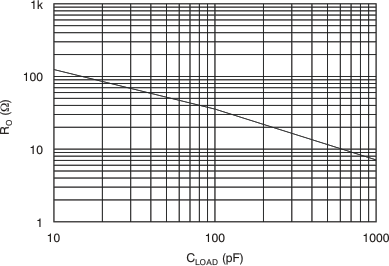 Figure 16. RO vs CLOAD RLOAD = 1 kΩ
Figure 16. RO vs CLOAD RLOAD = 1 kΩ
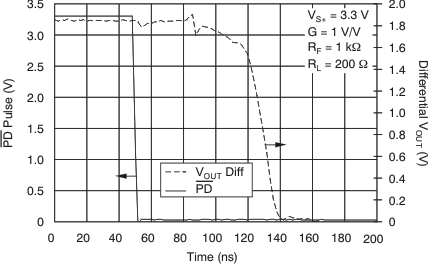 Figure 20. Turn-Off Time
Figure 20. Turn-Off Time
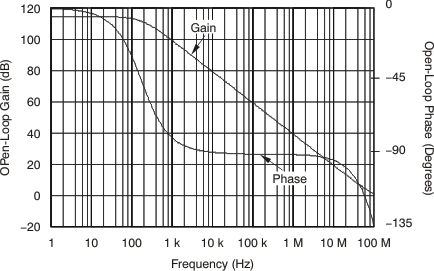 Figure 22. Main Amplifier Differential Open-Loop Gain and Phase
Figure 22. Main Amplifier Differential Open-Loop Gain and Phase
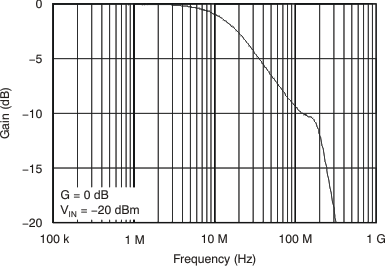 Figure 24. VOCM Small-Signal Frequency Response
Figure 24. VOCM Small-Signal Frequency Response
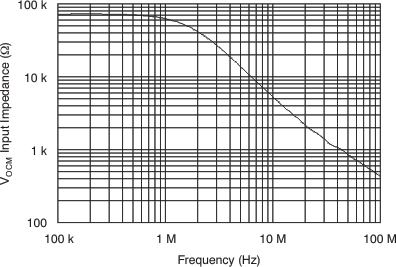 Figure 26. VOCM Input Impedance vs Frequency
Figure 26. VOCM Input Impedance vs Frequency
7.9 Typical Characteristics: 5 V
At VS+ = +5 V, VS– = 0 V, VOCM = open, VOUT = 2 VPP (differential), RF = 1 kΩ, RL = 1 kΩ differential, G = 1 V/V, single-ended input, differential output, and input and output referenced to midsupply, unless otherwise noted.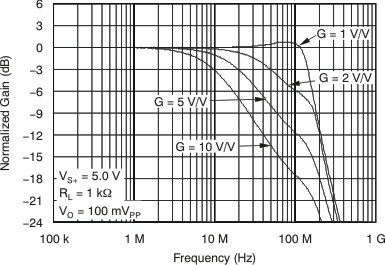 Figure 27. Small-Signal Frequency Response
Figure 27. Small-Signal Frequency Response
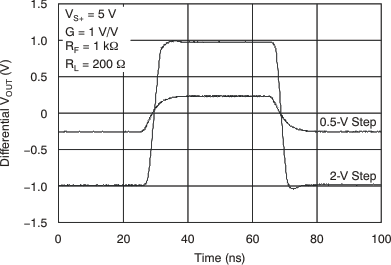 Figure 29. Large- and Small-Signal Pulse Response
Figure 29. Large- and Small-Signal Pulse Response
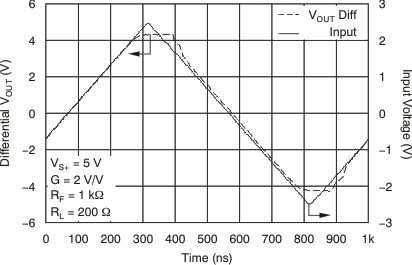 Figure 31. Overdrive Recovery
Figure 31. Overdrive Recovery
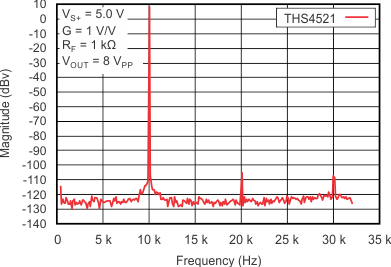 Figure 33. 10-kHz Output Spectrum On AP Analyzer at
Figure 33. 10-kHz Output Spectrum On AP Analyzer atVOUT = 8 VPP
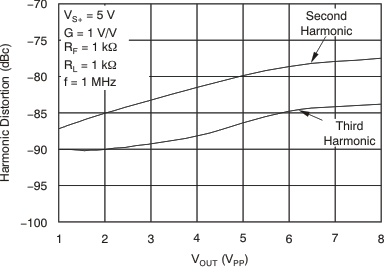 Figure 35. Harmonic Distortion vs VOUT at 1 MHz
Figure 35. Harmonic Distortion vs VOUT at 1 MHz
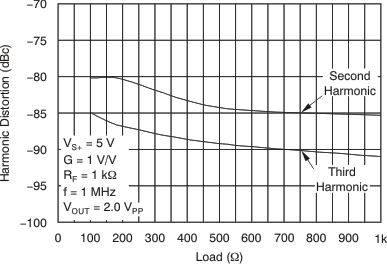 Figure 37. Harmonic Distortion vs Load at 1 MHz
Figure 37. Harmonic Distortion vs Load at 1 MHz
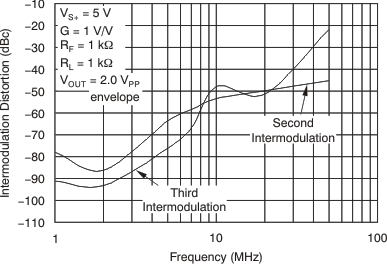 Figure 39. Two-Tone Intermodulation Distortion vs Frequency
Figure 39. Two-Tone Intermodulation Distortion vs Frequency
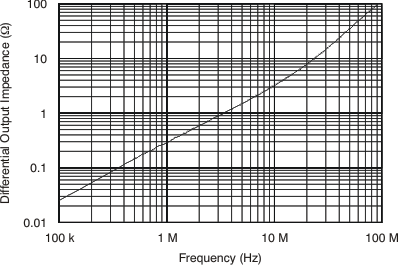 Figure 41. Main Amplifier Differential Output Impedance vs Frequency
Figure 41. Main Amplifier Differential Output Impedance vs Frequency
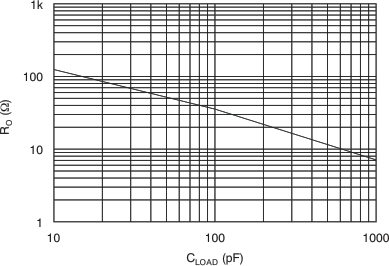 Figure 43. RO vs CLOAD RLOAD = 1 kΩ
Figure 43. RO vs CLOAD RLOAD = 1 kΩ
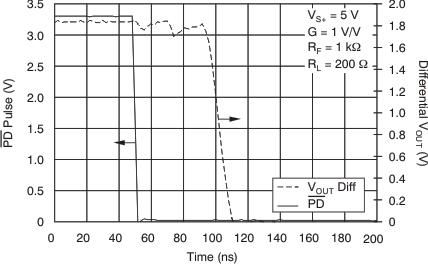 Figure 47. Turn-Off Time
Figure 47. Turn-Off Time
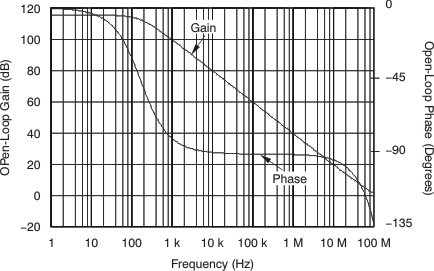 Figure 49. Main Amplifier Differential Open-Loop Gain and Phase
Figure 49. Main Amplifier Differential Open-Loop Gain and Phase
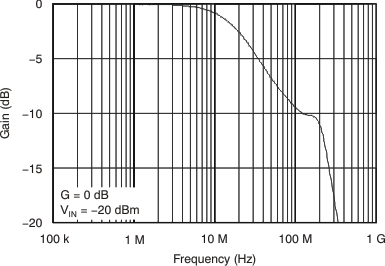 Figure 51. VOCM Small-Signal Frequency Response
Figure 51. VOCM Small-Signal Frequency Response
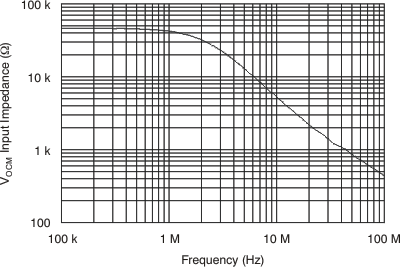 Figure 53. VOCM Input Impedance vs Frequency
Figure 53. VOCM Input Impedance vs Frequency
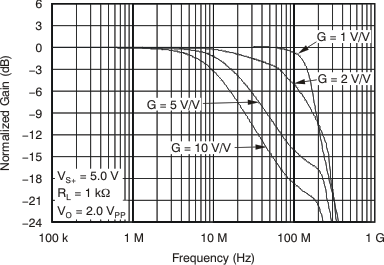 Figure 28. Large-Signal Frequency Response
Figure 28. Large-Signal Frequency Response
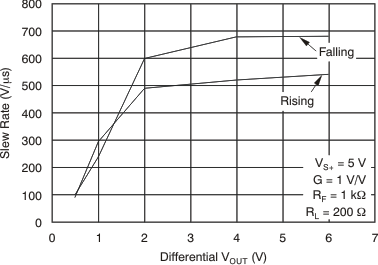 Figure 30. Slew Rate vs VOUT
Figure 30. Slew Rate vs VOUT
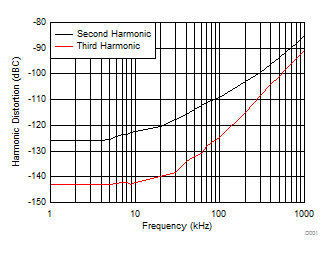 Figure 32. Harmonic Distortion vs Frequency Below 1 MHz
Figure 32. Harmonic Distortion vs Frequency Below 1 MHz
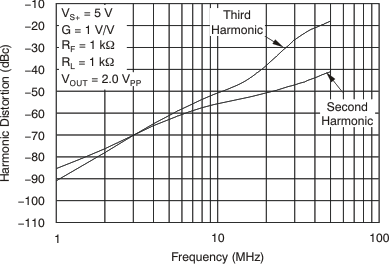 Figure 34. Harmonic Distortion vs Frequency
Figure 34. Harmonic Distortion vs Frequency
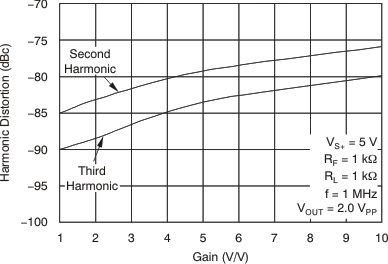 Figure 36. Harmonic Distortion vs Gain at 1 MHz
Figure 36. Harmonic Distortion vs Gain at 1 MHz
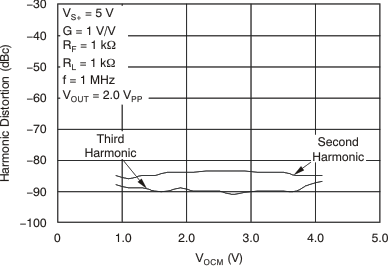 Figure 38. Harmonic Distortion vs VOCM at 1 MHz
Figure 38. Harmonic Distortion vs VOCM at 1 MHz
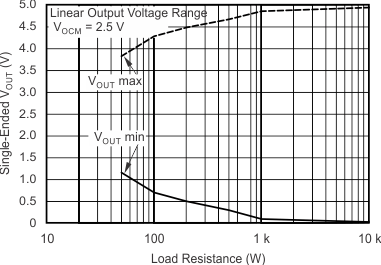 Figure 40. Single-Ended Output Voltage Swing vs Differential Load Resistance
Figure 40. Single-Ended Output Voltage Swing vs Differential Load Resistance
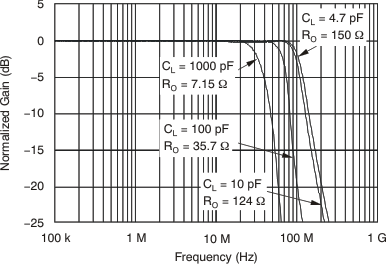 Figure 42. Frequency Response vs CLOAD RLOAD = 1 kΩ
Figure 42. Frequency Response vs CLOAD RLOAD = 1 kΩ
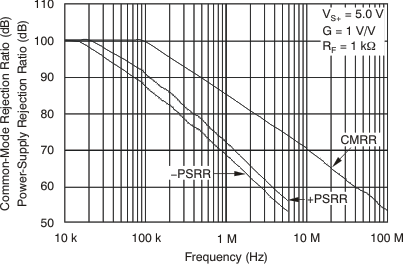 Figure 44. Rejection Ratio vs Frequency
Figure 44. Rejection Ratio vs Frequency
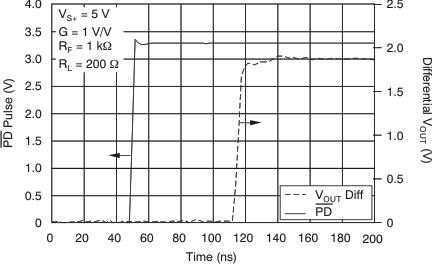 Figure 46. Turn-On Time
Figure 46. Turn-On Time
 Figure 48. Input-Referred Voltage and Current Noise Spectral Density
Figure 48. Input-Referred Voltage and Current Noise Spectral Density
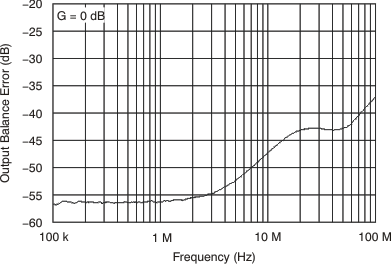 Figure 50. Output Balance Error vs Frequency
Figure 50. Output Balance Error vs Frequency
 Figure 52. VOCM Large-Signal Pulse Response
Figure 52. VOCM Large-Signal Pulse Response

